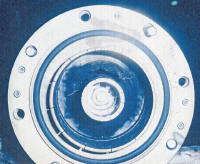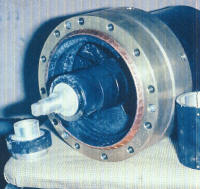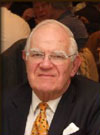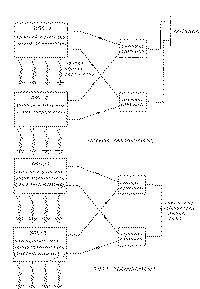|
BBCeng.info
Recollections of BBC engineering from 1922 to 1997 |
The British Broadcasting Corporation web site is: www.bbc.co.uk |
Transmitter Projects - Reminiscences
|
|
A Close Run Thing or how the Yorkshire Instinct saved the DayBy Geoff Platts |
Background
Following the 1960 report of the Television Advisory Committee and pan European negotiations, in 1961 a conference held in Stockholm formally confirmed the locations of transmitting sites, permissible transmitter powers and frequency allocations in the UHF frequency bands 470MHz – 582MHz and 614MHz – 854MHz for future television broadcasting in Europe so as to minimise the risk of mutual interference between transmitters operating on the same frequency.
Subsequently the British Government of the day accepted the recommendations of the Pilkington Committee, set up in 1960 to consider the future of television broadcasting in the UK, and the implications of the conference. The principal technical recommendations of the Committee, published in June 1962, were that:-
- a 625 line standard should be adopted for all new television
transmissions in the UK.
- it would be possible to provide national coverage of four programmes
using the UHF frequencies allocated to the UK.
- The BBC be authorised to start a second service, BBC-2, and that two of remaining channel allocations for each site should be reserved to duplicate the 405 line BBC-1 and ITA services using 625 lines prior to the eventual demise of 405 line services and release of their frequencies for other use, leaving the forth channel frequency allocations for a future programme.
Technical and economic considerations made it desirable to use existing BBC and ITA 405 line transmitting sites, so far as this was practicable in the overall plan, and to radiate all 625 line services in a given locality from the same antenna. However initially it was not known, with any degree of certainty, if the latter would be possible, but it was clear that some investment for future 625 line services would be unavoidable when facilities were provided for BBC-2.
The BBC and the ITA entered into a Landlord/Tennant agreement, each Authority to own half the UHF TV transmitter sites and provide, in addition to its own requirements, channel combining equipments, transmitter accommodation and antenna facilities specified by the Tennant.
 |
Fig. 1
The 708ft 6ins (219.6 m) Crystal Palace Tower with the BBC and ITA UHF Television Antennas enclosed, for weather protection, in the white GRP cylinder. (Click picture to enlarge) |
BBC Experiments, BBC2 and four-service policy
Prior to the recommendations of the Pilkington Committee the BBC had been transmitting experimentally on UHF Channels 34 and 44 from two antennas mounted on the Crystal Palace Tower above the antenna used to transmit the BBC's 405 line service. When the BBC were authorised to start BBC-2 the antenna used for the experimental Channel 34 transmissions was modified to operate on Channel 33, one of the four channels agreed for Crystal Palace at the Stockholm Conference, thus enabling the new BBC-2 service to start in the most densely populated part of the UK earlier than would otherwise have been possible. However financial considerations and technical expertise within the BBC led the BBC to proceed, with the exception of Crystal Palace which was subsequently re-engineered with two 2-Channel Antennas, on the assumption that antennas could be developed to radiate four services, and this policy in the event proved to be the correct one.
ITA policy
The ITA initially adopted the technically more cautious approach, indicated a desire to be as independent of the BBC as possible or were reluctant to invest in the future duplication of their 405 line service in the early days of 625 line television, by providing antennas for BBC-2 and subsequent duplication of BBC-1 at their sites and later providing separate antennas for duplicating their 405 line service and making provision for a forth programme.
Channel 4
The Pilkington Committee made no recommendation as to how any provision for a forth service should be financed, but from the outset the BBC and the ITA agreed that the latter should make such provision. This suited both parties: the BBC were short of cash, but the ITA was affluent, and presumably assumed such a policy would lead to its control of any future 4th Channel, which indeed it did.
Channel 5
The UHF frequency range 582MHz – 614MHz, not available for television at the time of the Stockholm Conference, eventually became available, but the channels allocated to the UK were inadequate for National coverage, hence Channel 5 programmes are only available in parts of the UK.
Continuity of service
To ensure continuity of service, all the main UHF transmitting stations were initially equipped with pairs of vision and sound transmitters for the BBC-2 service, alternative electricity supplies from different parts of the National Electricity Grid, except for the transmitter at Bilsdale in North Yorkshire, which was equipped with a gas turbine generator as there is no alternative power supply within a reasonable distance, and antennas in two halves with separate feeders specified to accept one or three additional channels as agreed between the BBC and the ITA. However the channel combining equipments to enable the BBC-1 and ITA 405 line and later Channel 4 services to be duplicated on 625 lines were not installed until required some years later after the start of BBC-2.
High power testing
When one of the additional transmitters for duplicating the 405 line BBC-1 service from Crystal Palace was first switched on everything appeared to be normal for short time, then the sound of arcing in the channel combining unit could be heard and almost immediately the transmitters were automatically shut down by reflectometers detecting power being reflected back to the transmitters rather than travelling up the feeders and being radiated by the antenna. Dismantling the channel combining unit, a task taking several hours, revealed nothing abnormal. The result of a second test was similar. We then reluctantly decided that we had no option but to render the reflectometers inoperative and risk damage to the transmitters in order to cause some visible damage in the channel combining unit. This we did and on dismantling the unit found that some ceramic insulators – heated in the same way as food in a domestic microwave oven – must have been white hot as they had actually melted, clearly causing the air in contact with them to ionise and initiate audible arcing. Fortunately the transmitters were not damaged and we were able to replace the insulators with ones of fused quartz, which has a very low dielectric loss and so does not get hot enough to result in arcing.
However in view of the channel combining unit failure we were fearful of the far-reaching consequences of any failure of the insulators in the main antenna feeders.
Not only was there to be a simultaneous opening, with dates already announced, of duplicated BBC-1 and ITA services from several transmitting stations, but more importantly any failure would result in the loss of the BBC-2 service.
Enquires revealed that the published power carrying capacity of the feeders had never been determined experimentally, but interpolated from tests at lower frequencies, because there was no transmitter or power absorbing load in existence to carry out such a test!
Yorkshire instinct!
Fortunately as the Project Leader responsible for the antenna systems at Crystal Palace and Sutton Goldfield, my Yorkshire instinct told me to save the off cuts (costing tens of £/m) when the main feeders were being installed, rather than dispose of them for scrap, particularly as they could be stored free of charge in existing ducts. We were able to recover and carry out tests on these off cuts by using one channel combiner to combine the outputs of one of the pairs of BBC-1 and BBC-2 transmitters and the other one in reverse so that the combined power could be divided and absorbed by water cooled loads as shown in Fig.2. In both cases the feeders were able to carry the power, but their connectors failed. Burnt out connectors are shown in Fig.3 and 4. Modified connectors were designed by BBC engineers and changed for the ones originally supplied, thus the day was saved in the nick of time. Subsequently a technique was developed by BBC engineers to test cables and connectors at high powers with relatively low power sources, analogous to how giving a child on a swing a series of little pushes at the right time results in the child swinging higher and higher.
 (Click pictures to enlarge) |
 |
|
| Fig. 2. Schematic of the working and test arrangements at Crystal Palace. | Figs. 3 and 4. Photographs of a connector with burnt out disc insulator. | |
Separate antennas at Crystal Palace
As mentioned earlier, the experimental antenna at Crystal Palace was modified to operate on Channel 33, but could not be further modified to transmit in addition the duplicated BBC-1, ITA and future Ch-4 programmes. Also there was a design constraint: the location of Crystal Palace in an urban area limited the vertical aperture of any antenna which would provide a satisfactory service, and hence the power handing capacity. For these reasons the upper part of the tower was modified to accommodate separate antennas, one above the other, for the BBC and ITA. An incidental advantage of this arrangement being the complete independence of the two broadcasting authorities at the UK's premier television transmitting site which provides a service to some 13,000,000 people. Fig. 1 shows the Crystal Palace tower with a white GRP cylinder enclosing the two antennas.
Return to list of Reminiscences


